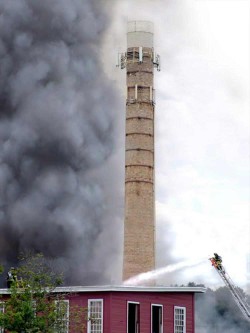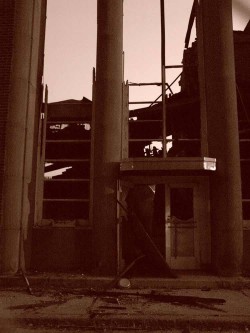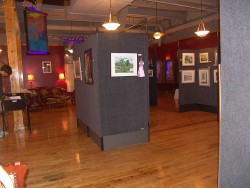Fortunately I Keep My Feathers Numbered for Just Such an Emergency
An artist’s survival guide on what to do when someone else’s fire burns 3 years of your work.
by: T. Mikey
Published in ARTisSpectrum (Vol. 19)
Download Original Publication
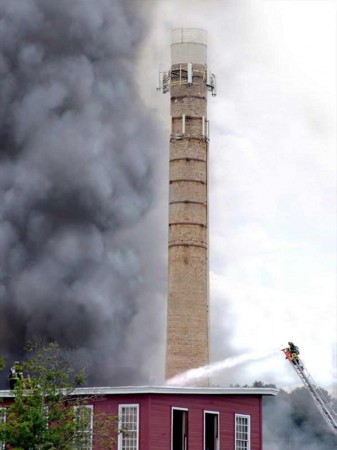
I was awakened on the morning of July 21 by a phone call telling me that the Bernat Mill Complex of Uxbridge MA has been burning to the ground since 4 AM. I wanted to scream, but was in far too much shock to do so. Everything I had in the mill was gone… 12 large scale 3D black- light paintings as well as others… These were pieces that I had worked very hard to create over the last few years. Representing a significant personal investment of time, money, and effort. Gone.
But instantly I knew, I would be all right. While I had no insurance, I was prepared.
Others would not be so lucky. Over 65 businesses operated in this mill employing over 500 people. No life was lost. But some of these people have just lost everything that they had in life, including their job.
Square footage was cheap, and I considered myself lucky to just have a small space where I could expose an unsuspecting public to my strange artistic experiments to begin with. Never once thought of insurance, it took most of my resources just to make the art happen at all. This is probably an all too common condition among most working artists.
But my loss can be described as money out of pocket and man- hours I can’t get back. But thanks to some simple precautions I had in place recovery would actually be possible under my own power. And if I were to maintain some perspective, my loss was comparatively small next to some of the people I used to pass in the hall every day.
A good friend of mine, Steve, operated his photo gallery out of the mill. Steve is 65, and financial losses aside for just a moment, he just lost 40 years of irreplaceable negatives. Every photo he’s ever taken. Basically, his life’s work. Gone.
And speaking solely as an artist and art lover, that just breaks my heart.
So over the past few weeks, the dust has been settling, the shock subsiding. And the now displaced local art community has raised certain questions, questions that any artist should probably take a moment to ponder.
Questions like, “What can we as artists do to avoid such a tragedy? And should the unthinkable happen, how do we minimize the loss, to our finances and to our one of a kind creations?”
The first thing that comes right to everyone’s mind is insurance. Because of recent events I have only now started to contemplate things like fine art insurance for the works I create. Potentially expensive, but I have just been taught the hard way what alterna- tive costs can be.
But in a more general sense, anytime any artist were to drop off a painting at a local coffee shop just to display and hopefully sell, you should really ask yourself, and the shop owner directly, “Should anything happen to my property while it’s in your care, am I covered for any loss, damage, or theft? Or am I assuming all the risk?” This is just a good practice to get into, but except for the more reputable and experienced galleries, most of the time you’ll probably find you’re on you own.
That said, should something actually happen to your work and you are not covered by someone else, take a look at your homeowners or renters insurance as it may cover you for what they consider “off premises loss”. If not, this is something you might want to look into, as it can be an economical way to have some basic coverage for your work. Homeowners’ policies have actu- ally helped cushion the blow for some people involved in this fire.
But perhaps you don’t have any insurance at all, as I didn’t, and this is a complete financial loss. How can you protect yourself from something like…. completely losing your life’s work?
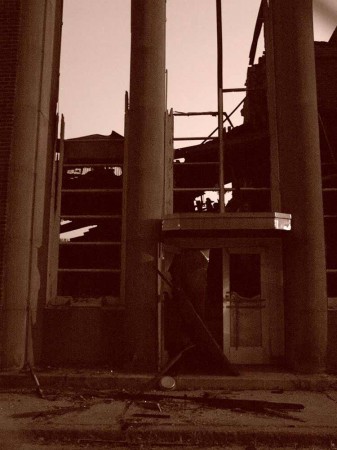
Most artists have their studio, and that’s it. Everything they have, the art they’ve made and the tools and materials they need to make more all in one convenient, often messy and disorganized place. And the first major precaution I could suggest it that you divide your space. Separate buildings if you can, but keep your inventory of artwork somewhere other than with your equipment needed to make more.
In the fire I only lost the work in my “display space”. All my equipment was safe and sound just up the street in my “work space”. Steve doesn’t even have a camera anymore.
In addition to keeping your artwork stored separately from your tools and equipment, I can’t stress enough to document and back- up every piece you make. For the cost of a digital camera and a hard drive you can save yourself from catastrophic loss. Should your original ever be destroyed, you will be forever grateful for the time that you spent taking just one high quality photograph of it.
This was the only insurance I had, and it’s the best 39 dollars a year I spend. Because even if you are completely financially covered, as an artist you might find yourself having lost something that a check cannot replace.
And with a proper back up you will find yourself in a much stronger position of recovery. And then you can begin to create again. And it’s hard, but if you can let go of the loss, and embrace the situation, this can be a tremendously freeing experience that can inspire creative energies you may not have known you even had.
The lost work, do you remake it? Can you remake it? Would you bother remaking it? Would you remake it slightly different than the original piece… an homage, or a memorial, or an “inspired by” type piece. Or just move on to new work?
Artistically, the future can hold great possibilities after being stripped of the past.
The moral of my little story, is that while I had no insurance, I had fully backed up and documented every piece I ever made. It’s been about 2 months now since the fire, and the site continues to be combed through by insurance adjusters that are still investigating the “cause”. And until they declare one, everyone waiting for insurance, just gets to wait.
But thanks to a little disaster planning, since the fire I’ve man- aged to reproduce ALL the work I lost that day…
And then I displayed it all publicly on my front lawn. In an art show I called, “The Lost in Fire Collection”. Some of the fire victims that came that night were amazed that I had managed to save the work from the fire. “How did you get these out of there?” they asked. I explained, “No, all that work was destroyed… I just did it again.”
Some said that they were inspired.
And isn’t that the gift that art truly gives?
When I last saw Steve he had a smile on his face, and was off to go race go-carts with his friends.
Artists can be a remarkably resilient people.
What saved me in the circumstance of this fire, was that I have my entire life’s work digitized and documented on a hard drive. But that’s not enough protection for my peace of mind. I then copied that hard drive and stored it miles away in a safety deposit box in the bank. More precaution than this might start to be overkill, but I rest securely knowing that no one single event can completely wipe out my entire life’s work.
A Gallery of Lost Art
